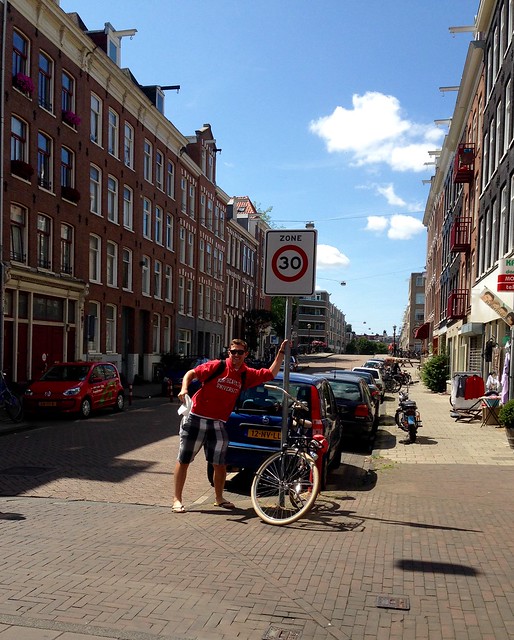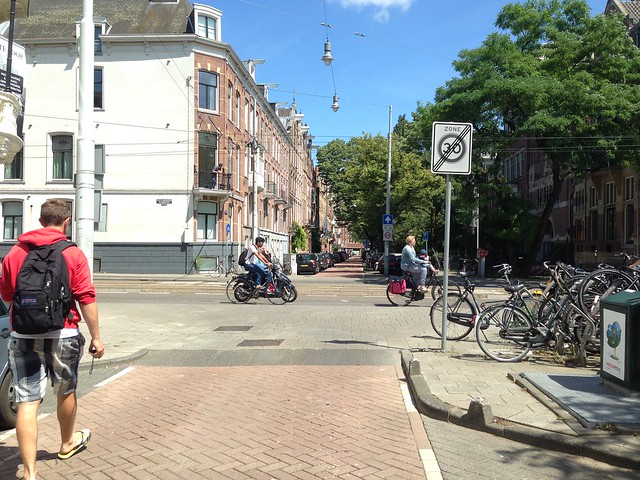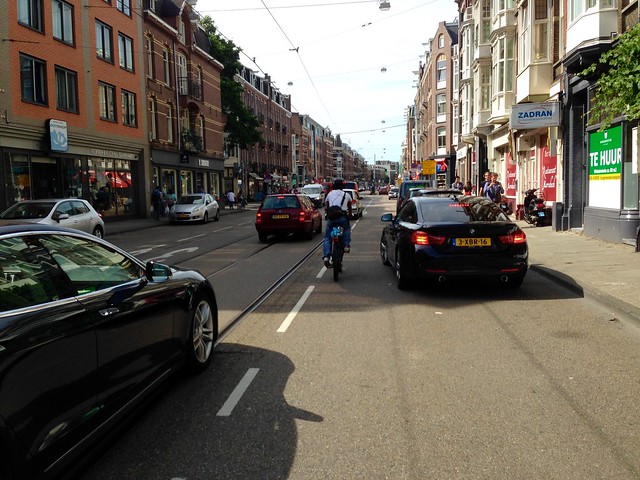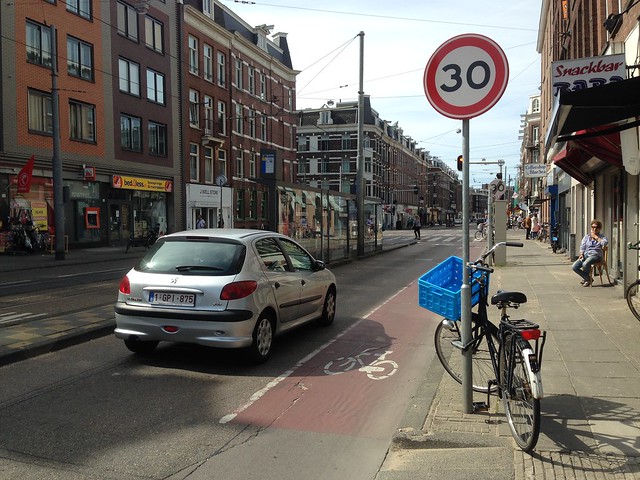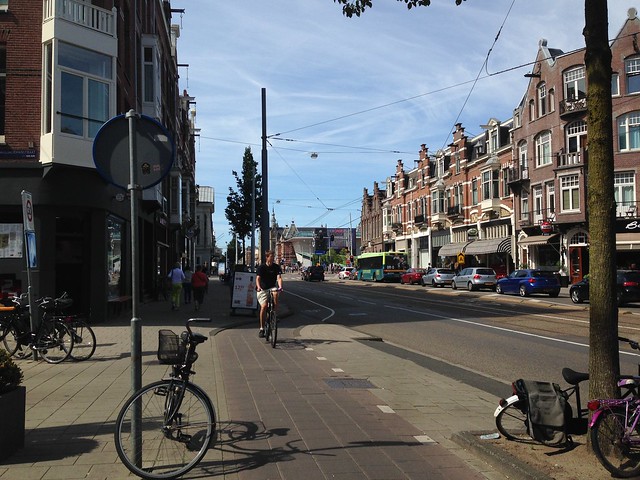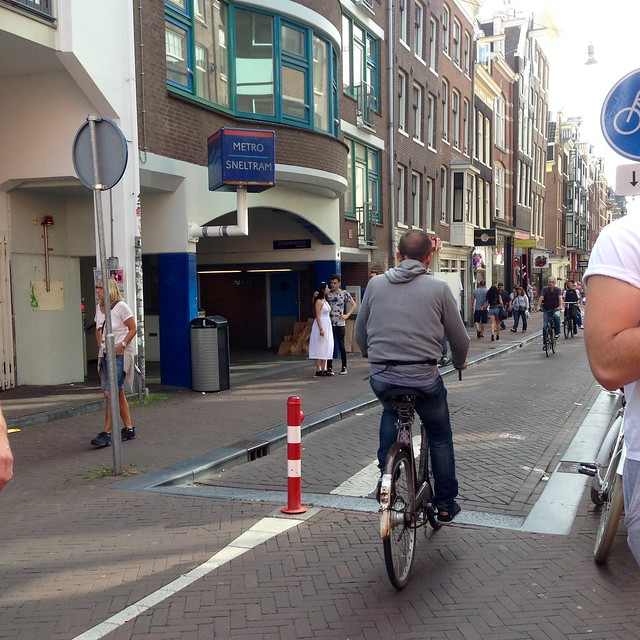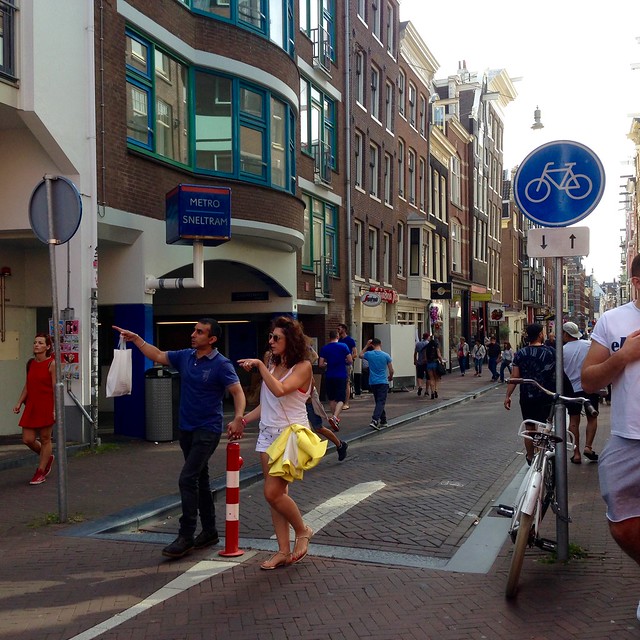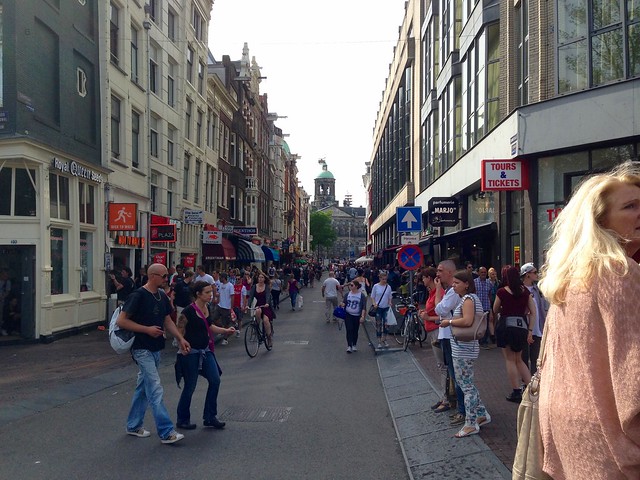Team: Joel, Katie L, Vanessa
The ring road located in Amsterdam’s Oud West and Oud Zuid neighborhoods – comprised of Hendrikstraat, Bilderdijkstraat, Huygensstraat, and Van Baerlestraat – is a 50 km/h (30 mph) distributor road connecting to 30 km/h (20 mph) neighborhood access streets. In order to increase driver awareness and reduce speeds when turning from the ring road to access streets, Amsterdam has installed entrance constructions that clearly delineate the beginning of the 30 km/h zone. (Demonstrated by TA Joel below).
Constructions typically include a speed table over which the sidewalks and one-way cycle tracks on either side of the ring road travel. The paving material of the sidewalks and cycle tracks continue through the intersection, clearly indicating bicyclist and pedestrian priority.
The results of this treatment are reduced turning speeds, vehicles yielding to bicyclists and pedestrians before transitioning to the neighborhood street, and increased visibility of potential intermodal conflicts. Signs indicating the beginning and end of the 30 km/h zone (depending on the direction traveled) accompany the raised crossings at the ring road to further increase awareness of the transition. The sign indicating the end of the 30 km/h zone can be seen in the photo below along with the signage marking the beginning of the 30 km/h residential zone across the 50 km/h distributor road.
Amsterdam also has entrance constructions on roads with bike lanes and no bike infrastructure. An example of this can be found on Van Woustraat in the Nieuwe Pijp neighborhood of the city. A raised pedestrian crossing is provided at the entrance to access streets, similar to the entrance treatments with cycle tracks. Two different bike lane treatments were observed at the entrance to 30 km/h zones. In the first method, bike lanes remain at street level with no special treatment which is a violation of sustainable safety by the city of Amsterdam. In the photo below the bikers along Van Woustraat are left without any bike facility and are forced to ride in the door zone. The biker in the photo is at risk of being doored, hit by the traveling vehicles or parked cars moving to traveling lane (as shown), or getting caught in the tram tracks with his bike tire.
Even when there is an entrance design along Van Woustraat, it is only noted by a sign (shown below) which is ineffective in slowing cars and enforce the 30 km/h limit. We observed many cars not change their speed from the 50 km/h zone to the 30 km/h stretch. This creates a dangerous situation for the bikers who have their own bike lane, but no physical separation from vehicles traveling ~50 km/h.
In the second (superior) method, bike lanes ramp up to sidewalk level and bend out from the street in order to provide queueing space for turning vehicles before encountering bicyclists. In the photo below, the cyclist just transitioned from the asphalt bike lane (at street grade) to the elevated one-way cycle track. This treatment follows sustainable safety ideology.
Entrance treatments have also been designed to provide pedestrian priority over all other modes, especially in areas with high volumes of pedestrians. At entrances to Oude Hoogstraat and Nieuwe Hoogstraat, a popular car-free shopping corridor near the city center, raised pedestrian crossings providing a continuation of the sidewalk inform bicyclists entering the street that they are entering a pedestrian-dominated area and should therefore yield to foot traffic.
While the change in grade and material separate the pedestrians and cyclists, the pedestrians still tend to dominate making it very difficult for cyclists to pass through Oude Hoogstraat. Below are pictures of how the street has become pedestrian dominant.
Overall Amsterdam’s facilities are heavily used by all modes of transportation. There are hundreds of entrances to residential zones off of the ring road which are designed to physically slow vehicles that are leaving the 50 km/h distributor road and crossing the cycle track and pedestrian sidewalk before they enter the 30 km/h zone. These zones are clearly demarcated by signs enforcing the change in speed limit and a change in material. Crossing tables and continuity of cycle tracks also slow the cars and warn that they do not have the priority upon entering a local road.
Van Woustraat did not follow sustainable safety principles despite several feeble attempts by the city of Amsterdam to decrease the speed limit in stretches lacking bike facilities. The road to was not designed to enforce the change in speed from 30 km/h to 50 km/h and therefore relies solely on signs in some areas. Other sections of the street incorporate a separate bike track which provides much more security for the riders, only to dump them back onto the unprotected street the next block. This street should be reconsidered by the city.
Biking in the city center on Oude Hoogstraat was a chaotic experience due to the volume of pedestrian traffic, mostly unaware of the cycle track condition in the center of the road. Biking in Amsterdam was a new and eye-opening experience as to how to retrofit an old, congested city with sufficient bike facilities, but I think I’ll stick to quiet, little Delft.
